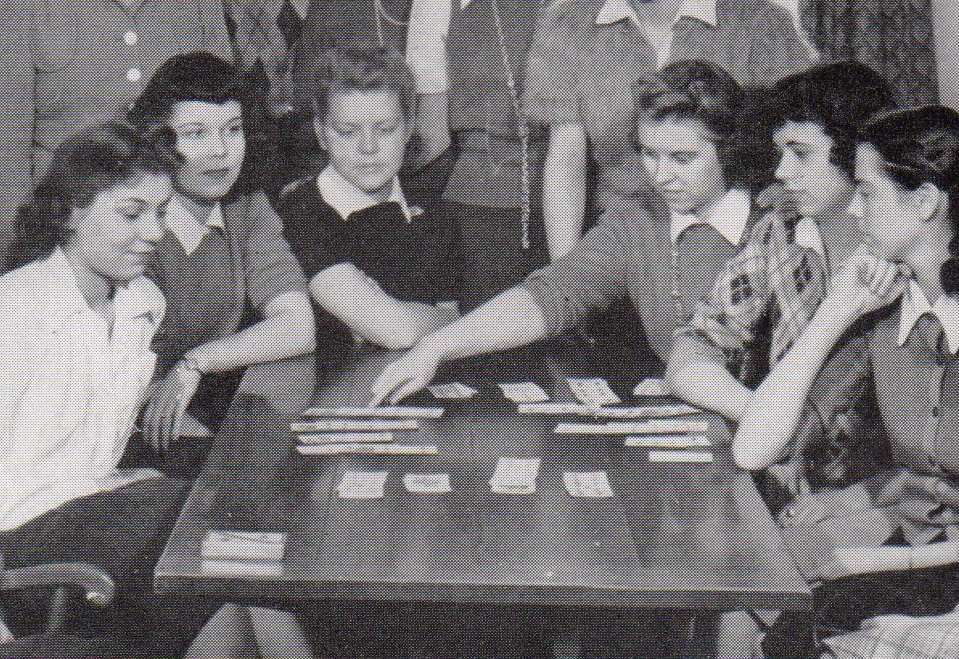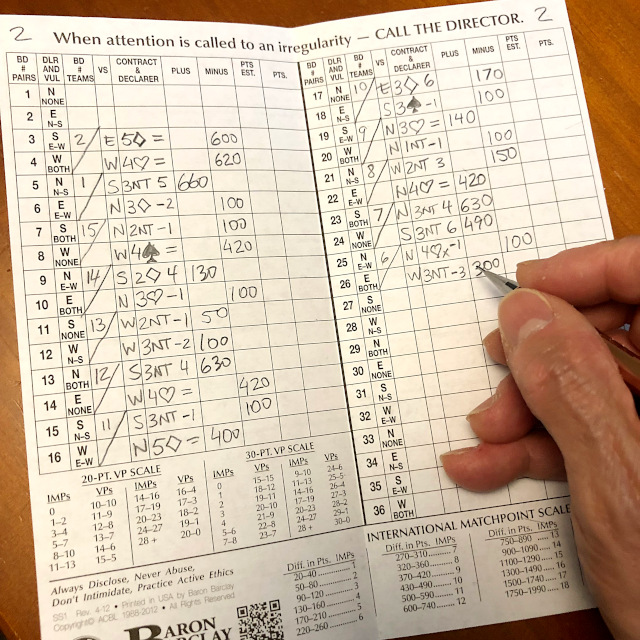|
Percentage Play
Percentage play in contract bridge is a play influenced by mathematical factors when more than one reasonable line of play is available. It is a generic name for plays in which declarer maximizes the chances for obtaining a certain number of tricks or the maximum number of tricks when considering the suit in isolation. Sometimes the percentage play is not the correct play considering the hand as a whole as an avoidance play or safety play may be more appropriate. In matchpoint games, which use comparative scoring, overtricks are very important, accordingly most hands are played simply to achieve the greatest number of tricks possible and risks may be taken to achieve overtricks that would not be considered at other types of scoring. Against a contract of 3NT West opens with the Q, and the A wins in dummy. In many types of bridge this hand calls for a safety play Safety play in contract bridge is a generic name for plays in which declarer maximizes the chances for fulfilling ... [...More Info...] [...Related Items...] OR: [Wikipedia] [Google] [Baidu] [Amazon] |
Contract Bridge
Contract bridge, or simply bridge, is a trick-taking game, trick-taking card game using a standard 52-card deck. In its basic format, it is played by four players in two Team game, competing partnerships, with partners sitting opposite each other around a table. Millions of people play bridge worldwide in clubs, bridge tournaments, tournaments, online and with friends at home, making it one of the world's most popular card games, particularly among Old Age, seniors. The World Bridge Federation (WBF) is the governing body for international competitive bridge, with numerous other bodies governing it at the regional level. The game consists of a number of , each progressing through four phases. The cards are to the players; then the players ''call'' (or ''bid'') in an seeking to take the , specifying how many tricks the partnership receiving the contract (the declaring side) needs to take to receive points for the deal. During the auction, partners use their bids to exchange infor ... [...More Info...] [...Related Items...] OR: [Wikipedia] [Google] [Baidu] [Amazon] |
Avoidance Play
In contract bridge, avoidance play is a play technique whereby declarer prevents a particular defender from winning the trick, so as to eschew a dangerous lead from that hand. The dangerous hand is usually the one who is able to finesse through declarer's honors, to give a ruff to the partner or to cash one or more established winners. Avoidance play can be regarded as one type of safety play. Example South plays 4 and West leads K (indicating the ace), East playing the 3 (signalling the odd number of hearts and discouraging the continuation). West continues with a club, increasing the probability of defensive ruff in that suit. The declarer has plenty of tricks, but is missing the trump queen and two top hearts; giving up the third heart early would probably mean losing the contract. Since A is almost certainly with West, if East gets the trump queen, he could finesse declarer's Q. Thus, the declarer must not allow East to get the trick, and so must play a trump first and finess ... [...More Info...] [...Related Items...] OR: [Wikipedia] [Google] [Baidu] [Amazon] |
Safety Play
Safety play in contract bridge is a generic name for plays in which declarer maximizes the chances for fulfilling the contract (or achieving a certain score) by ignoring a chance for a higher score. Declarer uses safety plays to cope with potentially unfavorable layouts of the opponent's cards. In so doing, declarer attempts to ensure the contract even in worst-case scenarios, by giving up the possibility of overtricks. Safety plays adapt declarer's strategy to the scoring system. In IMP-scoring tournaments and rubber bridge, the primary scoring reward comes from fulfilling the contract and overtricks are of little marginal value. Therefore, safety plays are an important part of declarer technique at quantitative scoring. In matchpoint games, which use comparative scoring, overtricks are very important. Therefore, although safety plays have a certain role at matchpoints, they are normally avoided if the odds for making the contract are good and overtricks are likely. Definit ... [...More Info...] [...Related Items...] OR: [Wikipedia] [Google] [Baidu] [Amazon] |
Duplicate Bridge
Duplicate bridge is a variation of contract bridge where the same set of bridge deals (i.e., the distribution of the 52 cards among the four hands) are played by different competitors, and scoring is based on relative performance. In this way, every hand, whether strong or weak, is played in competition with others playing identical cards, and the element of skill is heightened while that of chance is reduced. This stands in contrast to Bridge played without duplication, where each hand is freshly dealt and where scores may be more affected by chance in the short run. Four-way card holders known as Board (bridge), bridge boards are used to enable each player's hand to be preserved from table to table, and final scores are calculated by comparing each pair's result with others who played the same hand. In duplicate bridge, players normally play all the hands with the same partner, and compete either as a partnership (in a 'Pairs tournament') or on a team with one or more other p ... [...More Info...] [...Related Items...] OR: [Wikipedia] [Google] [Baidu] [Amazon] |
Contract Bridge Glossary
These terms are used in contract bridge, using duplicate or rubber scoring. Some of them are also used in whist, bid whist, the obsolete game auction bridge, and other trick-taking games. This glossary supplements the Glossary of card game terms. : ''In the following entries,'' boldface links ''are external to the glossary and'' plain links ''reference other glossary entries.'' 0–9 ;: A mnemonic for the original (Roman) response structure to the Roman Key Card Blackwood convention. It represents "3 or 0" and "1 or 4", meaning that the lowest step response (5) to the 4NT key card asking bid shows responder has three or zero keycards and the next step (5) shows one or four. ;: A mnemonic for a variant response structure to the Roman Key Card Blackwood convention. It represents "1 or 4" and "3 or 0", meaning that the lowest step response (5) to the 4NT key card asking bid shows responder has one or four keycards and the next step (5) shows three or zero. ;1RF: One round ... [...More Info...] [...Related Items...] OR: [Wikipedia] [Google] [Baidu] [Amazon] |
Finesse
In contract bridge and similar games, a finesse is a type of card play technique which will enable a player to win an additional trick or tricks should there be a favorable position of one or more cards in the hands of the opponents. The player attempts to win either the current trick or a later trick with a card of the suit he leads notwithstanding that the opponents hold a higher card in the suit; the attempt is based on the assumption that the higher card is held by a particular opponent. The specifics of the technique vary depending upon the suit combination being played and the number of tricks the player is attempting to win in that suit. Terminology To ''finesse a card'' is to play that card. Thus, in the example, the Queen is finessed. The outstanding King is the card finessed ''against'', or the card the player hopes to capture by the finessing maneuver. Thus, you finesse against a missing honor, but you finesse the card you yourself play, the card finessed being ... [...More Info...] [...Related Items...] OR: [Wikipedia] [Google] [Baidu] [Amazon] |
Suit Combinations
In the card game contract bridge, a suit combination is a specific subset of the cards of one suit held respectively in declarer's and dummy's hands at the onset of play. While the ranks of the remaining cards held by the defenders can be deduced precisely, their location is unknown. Optimum suit combination play allows for all possible lies of the cards held by the defenders. The term is also used for the sequence of plays from the declarer and dummy hands, conditional on intervening plays by the opponents; in other words, declarer's plan or strategy of play given his holdings and his goal for the number of tricks to be taken. In addition to understanding the possible initial combinations and probabilities for the location of the opponents' cards in a suit, declarer can further inform himself from the bidding, the opening lead and from the prior play of cards in establishing the probable location of remaining cards. Examples The diagram at left shows a heart suit combinatio ... [...More Info...] [...Related Items...] OR: [Wikipedia] [Google] [Baidu] [Amazon] |
Contract Bridge Card Play
A contract is an agreement that specifies certain legally enforceable rights and obligations pertaining to two or more parties. A contract typically involves consent to transfer of goods, services, money, or promise to transfer any of those at a future date. The activities and intentions of the parties entering into a contract may be referred to as contracting. In the event of a breach of contract, the injured party may seek judicial remedies such as damages or equitable remedies such as specific performance or rescission. A binding agreement between actors in international law is known as a treaty. Contract law, the field of the law of obligations concerned with contracts, is based on the principle that agreements must be honoured. Like other areas of private law, contract law varies between jurisdictions. In general, contract law is exercised and governed either under common law jurisdictions, civil law jurisdictions, or mixed-law jurisdictions that combine elements of ... [...More Info...] [...Related Items...] OR: [Wikipedia] [Google] [Baidu] [Amazon] |


